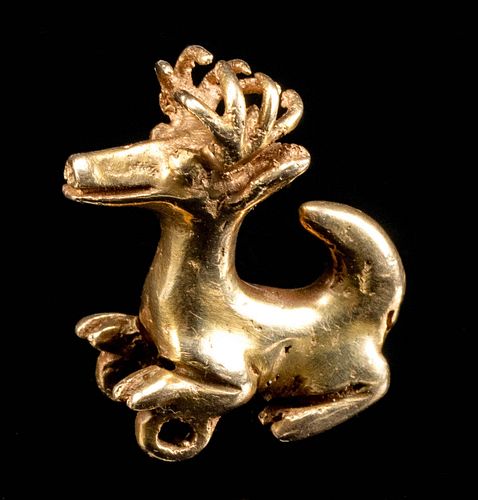Rare Panamanian Veraguas Tumbaga Deer Pendant
Lot 213
About Seller
Artemis Gallery
686 S Taylor Ave, Ste 106
Louisville, CO 80027
United States
Selling antiquities, ancient and ethnographic art online since 1993, Artemis Gallery specializes in Classical Antiquities (Egyptian, Greek, Roman, Near Eastern), Asian, Pre-Columbian, African / Tribal / Oceanographic art. Our extensive inventory includes pottery, stone, metal, wood, glass and textil...Read more
Estimate:
$8,000 - $12,000
Absentee vs Live bid
Two ways to bid:
- Leave a max absentee bid and the platform will bid on your behalf up to your maximum bid during the live auction.
- Bid live during the auction and your bids will be submitted real-time to the auctioneer.
Bid Increments
| Price | Bid Increment |
|---|---|
| $0 | $25 |
| $300 | $50 |
| $1,000 | $100 |
| $2,000 | $250 |
| $5,000 | $500 |
| $10,000 | $1,000 |
| $20,000 | $2,500 |
| $50,000 | $5,000 |
| $100,000 | $10,000 |
| $200,000 | $20,000 |
About Auction
By Artemis Gallery
Oct 7, 2021
Set Reminder
2021-10-07 10:00:00
2021-10-07 10:00:00
America/New_York
Bidsquare
Bidsquare : Exceptional Antiquities Ethnographic Fine Art
https://www.bidsquare.com/auctions/artemis-gallery/exceptional-antiquities-ethnographic-fine-art-7537
Museum-worthy examples of Egyptian, Greek, Roman, Etruscan, Near Eastern, Far East / Asian, Pre-Columbian, African / Tribal, Oceanic, Native American, Spanish Colonial, Fossils, Ancient Jewelry, Fine / Visual Arts, so much more! Artemis Gallery info@artemisgallery.com
Museum-worthy examples of Egyptian, Greek, Roman, Etruscan, Near Eastern, Far East / Asian, Pre-Columbian, African / Tribal, Oceanic, Native American, Spanish Colonial, Fossils, Ancient Jewelry, Fine / Visual Arts, so much more! Artemis Gallery info@artemisgallery.com
- Lot Description
Pre-Columbian, Panama or Costa Rica, Veraguas (Chiriqui), ca. 900 to 1550 CE. This is a stunning and solid tumbaga deer pendant cast via the lost wax method. Containing a high 56% (equivalent to 13K+) gold content. The recumbent deer is a handsome 8-point buck, with inward pointing antlers, almost forming a crown. The snout is elongated with incised mouth and nostrils. His legs are tucked under his body, the tail curved over his back, and his front feet have integral suspension loops so it can be worn, as an ornament. This piece is stunning and rare and precious example of the skilled metalworks from the Pre-Columbian world, which could be strung on a modern cord or chain as a wearable piece or simply displayed for its beauty. Size: 1.25" L x 0.5" W x 1.25" H (3.2 cm x 1.3 cm x 3.2 cm); quality of tumbaga: gold: 56% (equivalent to 13K+); silver quality: 12%; copper: 31%; weight 34.7 grams
Gold became the preferred material for creating fashionable ornaments in the Pre-Columbian world sometime after 500 CE replacing jadeite and other green stones from which artists had made impressive jewelry for centuries. Indeed, the ancient cultures of the New World created countless gold ornaments and ceremonial objects. Unfortunately, however, the Spanish conquistadors melted nearly all of these to convert them to gold bars and coins for Spain. Given this, surviving genuine pre-Columbian gold is rare and highly coveted by collectors.
Deer were revered animals that were hunted for sustenance and came to represent skilled hunters as well as fertility- their antlers growing in time with the seasons- budding in the spring and shedding in the winter. With a full rack, this buck was in the prime of the mating season, able to rival younger males, perhaps a representation of the original owner of this piece to demonstrate power and status. The lustrous golden hue that envelops the deer creates an alluring presentation.
For a similar example of this rare deer form, please see the Boston Museum of Fine Arts, accession number 1985.903.
This piece has been searched against the Art Loss Register database and has been cleared. The Art Loss Register maintains the world's largest database of stolen art, collectibles, and antiques.
Provenance: ex-private Van Buskirk collection, Tucson, Arizona USA
All items legal to buy/sell under U.S. Statute covering cultural patrimony Code 2600, CHAPTER 14, and are guaranteed to be as described or your money back.
A Certificate of Authenticity will accompany all winning bids.
PLEASE NOTE: Due to recent increases of shipments being seized by Australian & German customs (even for items with pre-UNESCO provenance), we will no longer ship most antiquities and ancient Chinese art to Australia & Germany. For categories of items that are acceptable to ship to Australia or Germany, please contact us directly or work with your local customs brokerage firm.
Display stands not described as included/custom in the item description are for photography purposes only and will not be included with the item upon shipping.
#167862Intact and choice. Surface is professionally cleaned. Surface pitting and abrasions. Chip to posterior.Condition
- Shipping Info
-
All shipping is handled in-house for your convenience. Your invoice from Artemis Gallery will include shipping calculation instructions. If in doubt, please inquire BEFORE bidding for estimated shipping costs for individual items.
-
- Buyer's Premium



 EUR
EUR CAD
CAD AUD
AUD GBP
GBP MXN
MXN HKD
HKD CNY
CNY MYR
MYR SEK
SEK SGD
SGD CHF
CHF THB
THB














